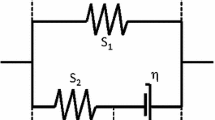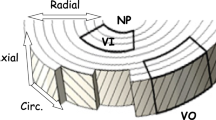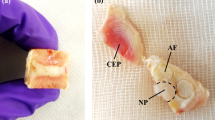Abstract
The effects of tissue hydration and fixed charge density on hydraulic permeability and creep behavior of cartilaginous tissues have been investigated using the triphasic theory and finite element methods. The empirical model for hydraulic permeability of uncharged gels and Mackie and Meares (1955) model for ion diffusivity were used in the numerical analysis. The hydraulic permeabilities of normal and trypsin-treated porcine annulus fibrosus tissues were measured indirectly. Analysis of the experimental data from this study and in literature indicates that the water content plays a more important role in regulating tissue permeability than fixed charge density for normal tissues. A change in glycosaminoglycan content will change both triphasic closed-circuit (or intrinsic) and biphasic open-circuit permeabilities of cartilaginous tissues. Analysis also shows that both fixed charge density and water content play an important role in tissue creep response. This study adds new knowledge to the permeability and creep behavior of cartilaginous tissues and is important for understanding the nutrition in intervertebral disk. © 2003 Biomedical Engineering Society.
PAC2003: 8719Tt, 8710+e, 8719Uv
Similar content being viewed by others
References
Argoubi, M., and A. Shirazi-Adl. Poroelastic creep response analysis of a lumbar motion segment in compression. J. Biomech. 29:1331–1339, 1996.
Best, B. A., F. Guilak, L. A. Setton, W. Zhu, F. Saed-Nejad, A. Ratcliffe, M. Weidenbaum, and V. C. Mow. Compressive mechanical properties of the human anulus fibrosus and their relationship to biochemical composition. Spine19:212–221, 1994.
Bibby, S. R., J. C. Fairbank, M. R. Urban, and J. P. Urban. Cell viability in scoliotic discs in relation to disc deformity and nutrient levels. Spine27:2220–2228, 2002.
Chammas, P., W. J. Federspiel, and S. R. Eisenberg. A microcontinuum model of electrokinetic coupling in the extracellular matrix: Perturbation formulation and solution. J. Colloid Interface Sci. 168:526–538, 1994.
Crock, H. V., and M. Goldwasser. Anatomic studies of the circulation in the region of the vertebral end-plate in adult Greyhound dogs. Spine9:702–706, 1984.
Drost, M. R., P. Willems, H. Snijders, J. M. Huyghe, J. D. Janssen, and A. Huson. Confined compression of canine annulus fibrosus under chemical and mechanical loading. J. Biomech. Eng. 117:390–396, 1995.
Ehlers, W., and B. Markert. A linear viscoelastic biphasic model for soft tissues based on the theory of porous media. J. Biomech. Eng. 123:418–424, 2001.
Eisenberg, S. R., and A. J. Grodzinsky. Electrokinetic micromodel of extracellular-matrix and other polyelectrolyte networks. PhysicoChemical Hydrodynamics10:517–539, 1988.
Frank, E. H., and A. J. Grodzinsky. Cartilage electromechanics—I. Electrokinetic transduction and the effects of electrolyte pH and ionic strength. J. Biomech. 20:615–627, 1987.
Frank, E. H., and A. J. Grodzinsky. Cartilage electromechanics—II. A continuum model of cartilage electrokinetics and correlation with experiments. J. Biomech. 20:629–639, 1987.
Frank, E. H., A. J. Grodzinsky, S. L. Phillips, and P. E. Grimshaw. Physiochemical and bioelectrical determinants of cartilage material properties. In: Biomechanics of Diarthrodial Joints, edited by V. C. Mow, D. O. Wood, and S. L. Woo. New York: Springer, 1990, pp. 261–282.
Grodzinsky, A. J. Electromechanical and physicochemical properties of connective tissue. Crit. Rev. Biomed. Eng. 9:133–199, 1983.
Gu, W. Y., M. A. Justiz, and H. Yao. Electrical conductivity of lumbar annulus fibrosis: Effects of porosity and fixed charge density. Spine27:2390–2395, 2002.
Gu, W. Y., and M. A. Justiz. Apparatus for measuring the swelling dependent electrical conductivity of charged hydrated soft tissues. J. Biomech. Eng. 124:790–793, 2002.
Gu, W. Y., W. M. Lai, and V. C. Mow. Theoretical basis for measurements of cartilage fixed-charge density using streaming current and electro-osmosis effects. Adv. Bioeng. 26:55–58, 1993.
Gu, W. Y., W. M. Lai, and V. C. Mow. Transport of fluid and ions through a porous-permeable charged-hydrated tissue, and streaming potential data on normal bovine articular cartilage. J. Biomech. 26:709–723, 1993.
Gu, W. Y., W. M. Lai, and V. C. Mow. A mixture theory for charged-hydrated soft tissues containing multielectrolytes: passive transport and swelling behaviors. J. Biomech. Eng. 120:169–180, 1998.
Gu, W. Y., W. M. Lai, and V. C. Mow. Transport of multi-electrolytes in charged hydrated biological soft tissues. Transp. Porous Media34:143–157, 1999.
Gu, W. Y., X. G. Mao, R. J. Foster, M. Weidenbaum, V. C. Mow, and B. A. Rawlins. The anisotropic hydraulic permeability of human lumbar anulus fibrosus. Influence of age, degeneration, direction, and water content. Spine24:2449–2455, 1999.
Gu, W. Y., H. Yao, C.-Y. Huang, and H. S. Cheung. New insight into deformation-dependent hydraulic permeability of gels and cartilage, and dynamic behavior of agarose gels in confined compression. J. Biomech. 36:593–598, 2003.
Happel, J. Viscous flow relative to arrays of cylinders. AIChE J. 5:174–177, 1959.
Helfferich, F. Ion Exchange. New York: McGraw-Hill, 1962.
Holm, S., A. Maroudas, J. P. Urban, G. Selstam, and A. Nachemson. Nutrition of the intervertebral disc: Solute transport and metabolism. Connect. Tissue Res. 8:101–119, 1981.
Holm, S., and A. Nachemson. Nutritional changes in the canine intervertebral disc after spinal fusion. Clin. Orthop. 169:243–258, 1982.
Holmes, M. H., and V. C. Mow. The nonlinear characteristics of soft gels and hydrated connective tissues in ultrafiltration. J. Biomech. 23:1145–1156, 1990.
Horner, H. A., and J. P. Urban. 2001 Volvo Award Winner in Basic Science Studies: Effect of nutrient supply on the viability of cells from the nucleus pulposus of the intervertebral disc. Spine26:2543–2549, 2001.
Houben, G. B., M. R. Drost, J. M. Huyghe, J. D. Janssen, and A. H. Husson. Nonhomogeneous permeability of canine anulus fibrosus. Spine1:7–16, 1997.
Huyghe, J. M., and J. D. Janssen. Quadriphasic mechanics of swelling incompressible porous media. Int. J. Eng. Sci. 35:793–802, 1997.
Iatridis, J. C., L. A. Setton, R. J. Foster, B. A. Rawlins, M. Weidenbaum, and V. C. Mow. Degeneration affects the anisotropic and nonlinear behaviors of human anulus fibrosus in compression. J. Biomech. 31:535–544, 1998.
Jackson, G. W., and D. F. James. The permeability of fibrous porous media. Can. J. Chem. Eng. 64:364–374, 1986.
Johnson, E. M., and W. M. Deen. Hydraulic permeability of agarose gels. AIChE J. 42:1220–1224, 1996.
Katchalsky, A., and P. F. Curran. Nonequilibrium Thermodynamics in Biophysics. Cambridge: Harvard University Press, 1975.
Klisch, S. M., and J. C. Lotz. A special theory of biphasic mixtures and experimental results for human annulus fibrosus tested in confined compression. J. Biomech. Eng. 122:180–188, 2000.
Koneshan, S., J. C. Rasaiah, R. M. Lynden-Bell, and S. H. Lee. Solvent structure, dynamics, and ion mobility in aqueous solution at 25°C. J. Phys. Chem. 102:4193–4204, 1998.
Koponen, A., M. Kataja, and J. Timonen. Permeability and effective porosity of porous media. Phys. Rev. E56:3319–3325, 1997.
Lai, W. M., J. S. Hou, and V. C. Mow. A triphasic theory for the swelling and deformation behaviors of articular cartilage. J. Biomech. Eng. 113:245–258, 1991.
Lai, W. M., and V. C. Mow. Drag-induced compression of articular cartilage during a permeation experiment. Biorheology17:111–123, 1980.
Lai, W. M., V. C. Mow, D. D. Sun, and G. A. Ateshian. On the electric potentials inside a charged soft hydrated biological tissue: Streaming potential versus diffusion potential. J. Biomech. Eng. 122:336–346, 2000.
Lee, R. C., E. H. Frank, A. J. Grodzinsky, and D. K. Roylance. Oscillatory compressional behavior of articular cartilage and its associated electro-mechanical properties. J. Biomech. Eng. 103:280–292, 1981.
Mackie, J. S., and P. Meares. The diffusion of electrolytes in a cation-exchange resin—I. theoretical. Proc. R. Soc. London, Ser. A232:498–509, 1955.
Maroudas, A. Physicochemical properties of cartilage in the light of ion exchange theory. Biophys. J. 8:575–595, 1968.
Maroudas, A. Biophysical chemistry of cartilaginous tissues with special reference to solute and fluid transport. Biorheology12:233–248, 1975.
Maroudas, A., R. A. Stockwell, A. Nachemson, and J. Urban. Factors involved in the nutrition of the human lumbar intervertebral disc: Cellularity and diffusion of glucose. J. Anat. 120:113–130, 1975.
Moore, R. J., O. L. Osti, B. Vernon-Roberts, and R. D. Fraser. Changes in endplate vascularity after an outer anulus tear in the sheep. Spine17:874–878, 1992.
Mow, V. C., G. A. Ateshian, W. M. Lai, and W. Y. Gu. Effects of fixed charge density on the stress-relaxation behavior of hydrated soft tissues in a confined compression problem. Int. J. Space Struct. 35:4945–4962, 1998.
Mow, V. C., S. C. Kuei, W. M. Lai, and C. G. Armstrong. Biphasic creep and stress relaxation of articular cartilage in compression: Theory and experiments. J. Biomech. Eng. 102:73–84, 1980.
Mow, V. C., and W. M. Lai. Selected unresolved problems in synovial joint biomechanics. In: Proceedings of Biomechanics Symposium, edited by W. Van Buskirk. New York: ASME, 1979, pp. 19–52.
Nachemson, A., T. Lewin, A. Maroudas, and M. A. Freeman. diffusion of dye through the end-plates and the annulus fibrosus of human lumbar inter-vertebral discs. Geotech. Eng. 41:589–607, 1970.
Ogata, K., and L. A. Whiteside. 1980 Volvo award winner in basic science. Nutritional pathways of the intervertebral disc. An experimental study using hydrogen washout technique. Int. J. Space Struct. 6:211–216, 1981.
Ohshima, H., H. Tsuji, N. Hiarano, H. Ishihara, Y. Katoh, and H. Yamada. Water diffusion pathway, swelling pressure, and biomechanical properties of the intervertebral disc during compression load. Int. J. Space Struct. 14:1234–1244, 1989.
Riches, P. E., N. Dhillon, J. Lotz, A. W. Woods, and D. S. McNally. The internal mechanics of the intervertebral disc under cyclic loading. J. Biomech. 35:1263–1271, 2002.
Roberts, S., J. P. Urban, H. Evans, and S. M. Eisenstein. Transport properties of the human cartilage endplate in relation to its composition and calcification. Int. J. Space Struct. 21:415–420, 1996.
Setton, L. A., W. Zhu, M. Weidenbaum, A. Ratcliffe, and V. C. Mow. Compressive properties of the cartilaginous end-plate of the baboon lumbar spine. J. Orthop. Res. 11:228–239, 1993.
Sun, D. N., W. Y. Gu, X. E. Guo, W. M. Lai, and V. C. Mow. A mixed finite element formulation of triphasic mechano-electrochemical theory for charged, hydrated biological soft tissues. Int. J. Numer. Methods Eng. 45:1375–1402, 1999.
Urban, J. P. The role of the physicochemical environment in determining disc cell behaviour. Biochem. Soc. Trans. 30:858–864, 2001.
Urban, J. P., S. Holm, and A. Maroudas. Diffusion of small solutes into the intervertebral disc: As study. Biorheology15:203–221, 1978.
Urban, J. P. G., S. Holms, A. Maroudas, and A. Nachemson. Nutrition of the intervertebral disc: An study of solute transport. Clin. Orthop. 129:101–114, 1977.
Yao, H., and W. Y. Gu. New insight into deformation-dependent hydraulic permeability of hydrogels and cartilage. Adv. Bioeng. 53:32520, 2002.
Yao, H., M. A. Justiz, D. Flagler, and W. Y. Gu. Effects of swelling pressure and hydraulic permeability on dynamic compressive behavior of lumbar annulus fibrosus. Ann. Biomed. Eng. 30:1234–1241, 2002.
Author information
Authors and Affiliations
Rights and permissions
About this article
Cite this article
Gu, W.Y., Yao, H. Effects of Hydration and Fixed Charge Density on Fluid Transport in Charged Hydrated Soft Tissues. Annals of Biomedical Engineering 31, 1162–1170 (2003). https://doi.org/10.1114/1.1615576
Issue Date:
DOI: https://doi.org/10.1114/1.1615576




